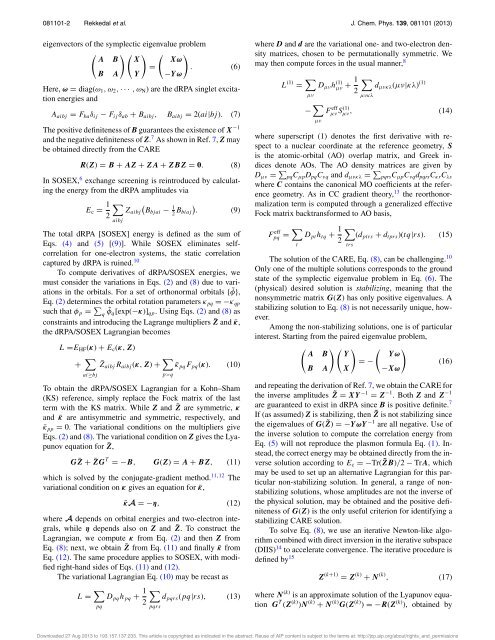Analytic gradients in the random-phase approximation
Analytic gradients in the random-phase approximation
Analytic gradients in the random-phase approximation
Create successful ePaper yourself
Turn your PDF publications into a flip-book with our unique Google optimized e-Paper software.
081101-2 Rekkedal et al. J. Chem. Phys. 139, 081101(2013)<br />
eigenvectors of <strong>the</strong> symplectic eigenvalue problem<br />
( ) ( )<br />
A B X Xω<br />
= . (6)<br />
B A)(<br />
Y −Yω<br />
Here, ω = diag(ω 1 ,ω 2 , ··· ,ω N )are<strong>the</strong>dRPAs<strong>in</strong>gletexcitation<br />
energies and<br />
A aibj = F ba δ ij − F ij δ ab + B aibj , B aibj = 2(ai|bj ). (7)<br />
The positive def<strong>in</strong>iteness of B guarantees <strong>the</strong> existence of X −1<br />
and <strong>the</strong> negative def<strong>in</strong>iteness of Z. 7 As shown <strong>in</strong> Ref. 7, Z may<br />
be obta<strong>in</strong>ed directly from <strong>the</strong> CARE<br />
R(Z) = B + AZ + ZA+ ZBZ = 0. (8)<br />
In SOSEX, 6 exchange screen<strong>in</strong>g is re<strong>in</strong>troduced by calculat<strong>in</strong>g<br />
<strong>the</strong> energy from <strong>the</strong> dRPA amplitudes via<br />
E c = 1 ∑ (<br />
Z aibj Bbj ai − 1 2<br />
2<br />
B biaj)<br />
. (9)<br />
aibj<br />
The total dRPA [SOSEX] energy is def<strong>in</strong>ed as <strong>the</strong> sum of<br />
Eqs. (4) and (5) [(9)]. While SOSEX elim<strong>in</strong>ates selfcorrelation<br />
for one-electron systems, <strong>the</strong> static correlation<br />
captured by dRPA is ru<strong>in</strong>ed. 10<br />
To compute derivatives of dRPA/SOSEX energies, we<br />
must consider <strong>the</strong> variations <strong>in</strong> Eqs. (2) and (8) due to variations<br />
<strong>in</strong> <strong>the</strong> orbitals. For a set of orthonormal orbitals { ˜φ},<br />
Eq. (2) determ<strong>in</strong>es <strong>the</strong> orbital rotation parameters κ pq =−κ qp<br />
such that φ p = ∑ q ˜φ q [exp(−κ)] qp . Us<strong>in</strong>g Eqs. (2) and (8) as<br />
constra<strong>in</strong>ts and <strong>in</strong>troduc<strong>in</strong>g <strong>the</strong> Lagrange multipliers ¯Z and ¯κ,<br />
<strong>the</strong> dRPA/SOSEX Lagrangian becomes<br />
L =E HF (κ) + E c (κ, Z)<br />
+ ∑ ¯Z aibj R aibj (κ, Z) + ∑ ¯κ pq F pq (κ). (10)<br />
p>q<br />
ai≥bj<br />
To obta<strong>in</strong> <strong>the</strong> dRPA/SOSEX Lagrangian for a Kohn–Sham<br />
(KS) reference, simply replace <strong>the</strong> Fock matrix of <strong>the</strong> last<br />
term with <strong>the</strong> KS matrix. While Z and ¯Z are symmetric, κ<br />
and ¯κ are antisymmetric and symmetric, respectively, and<br />
¯κ pp = 0. The variational conditions on <strong>the</strong> multipliers give<br />
Eqs. (2) and (8).ThevariationalconditiononZ gives <strong>the</strong> Lyapunov<br />
equation for ¯Z,<br />
G ¯Z + ¯ZG T =−B, G(Z) = A + BZ, (11)<br />
which is solved by <strong>the</strong> conjugate-gradient method. 11, 12 The<br />
variational condition on κ gives an equation for ¯κ,<br />
¯κA =−η, (12)<br />
where A depends on orbital energies and two-electron <strong>in</strong>tegrals,<br />
while η depends also on Z and ¯Z. Toconstruct<strong>the</strong><br />
Lagrangian, we compute κ from Eq. (2) and <strong>the</strong>n Z from<br />
Eq. (8); next,weobta<strong>in</strong> ¯Z from Eq. (11) and f<strong>in</strong>ally ¯κ from<br />
Eq. (12). ThesameprocedureappliestoSOSEX,withmodified<br />
right-hand sides of Eqs. (11) and (12).<br />
The variational Lagrangian Eq. (10) may be recast as<br />
L = ∑ pq<br />
D pq h pq + 1 ∑<br />
d pqrs (pq|rs), (13)<br />
2<br />
pqrs<br />
where D and d are <strong>the</strong> variational one- and two-electron density<br />
matrices, chosen to be permutationally symmetric. We<br />
may <strong>the</strong>n compute forces <strong>in</strong> <strong>the</strong> usual manner, 8<br />
L (1) = ∑ µν<br />
− ∑ µν<br />
D µν h (1)<br />
µν + 1 ∑<br />
d µνκλ (µν|κλ) (1)<br />
2<br />
µνκλ<br />
F eff<br />
µν S(1) µν , (14)<br />
where superscript (1) denotes <strong>the</strong> first derivative with respect<br />
to a nuclear coord<strong>in</strong>ate at <strong>the</strong> reference geometry, S<br />
is <strong>the</strong> atomic-orbital (AO) overlap matrix, and Greek <strong>in</strong>dices<br />
denote AOs. The AO density matrices are given by<br />
D µν = ∑ pqC µp D pq C νq and d µνκλ = ∑ pqrsC µp C νq d pqrs C κr C λs<br />
where C conta<strong>in</strong>s <strong>the</strong> canonical MO coefficients at <strong>the</strong> reference<br />
geometry. As <strong>in</strong> CC gradient <strong>the</strong>ory, 13 <strong>the</strong> reorthonormalization<br />
term is computed through a generalized effective<br />
Fock matrix backtransformed to AO basis,<br />
F eff<br />
pq = ∑ t<br />
D pt h tq + 1 ∑<br />
(d ptrs + d tprs )(tq|rs). (15)<br />
2<br />
trs<br />
The solution of <strong>the</strong> CARE, Eq. (8),canbechalleng<strong>in</strong>g. 10<br />
Only one of <strong>the</strong> multiple solutions corresponds to <strong>the</strong> ground<br />
state of <strong>the</strong> symplectic eigenvalue problem <strong>in</strong> Eq. (6). The<br />
(physical) desired solution is stabiliz<strong>in</strong>g, mean<strong>in</strong>gthat<strong>the</strong><br />
nonsymmetric matrix G(Z) hasonlypositiveeigenvalues.A<br />
stabiliz<strong>in</strong>g solution to Eq. (8) is not necessarily unique, however.<br />
Among <strong>the</strong> non-stabiliz<strong>in</strong>g solutions, one is of particular<br />
<strong>in</strong>terest. Start<strong>in</strong>g from <strong>the</strong> paired eigenvalue problem,<br />
( ) ( )<br />
A B Y Yω<br />
=−<br />
(16)<br />
B A)(<br />
X −Xω<br />
and repeat<strong>in</strong>g <strong>the</strong> derivation of Ref. 7,weobta<strong>in</strong><strong>the</strong>CAREfor<br />
<strong>the</strong> <strong>in</strong>verse amplitudes ˜Z = XY −1 = Z −1 .BothZ and Z −1<br />
are guaranteed to exist <strong>in</strong> dRPA s<strong>in</strong>ce B is positive def<strong>in</strong>ite. 7<br />
If (as assumed) Z is stabiliz<strong>in</strong>g, <strong>the</strong>n ˜Z is not stabiliz<strong>in</strong>g s<strong>in</strong>ce<br />
<strong>the</strong> eigenvalues of G( ˜Z) =−YωY −1 are all negative. Use of<br />
<strong>the</strong> <strong>in</strong>verse solution to compute <strong>the</strong> correlation energy from<br />
Eq. (5) will not reproduce <strong>the</strong> plasmon formula Eq. (1). Instead,<br />
<strong>the</strong> correct energy may be obta<strong>in</strong>ed directly from <strong>the</strong> <strong>in</strong>verse<br />
solution accord<strong>in</strong>g to E c =−Tr( ˜ZB)/2 − Tr A, which<br />
may be used to set up an alternative Lagrangian for this particular<br />
non-stabiliz<strong>in</strong>g solution. In general, a range of nonstabiliz<strong>in</strong>g<br />
solutions, whose amplitudes are not <strong>the</strong> <strong>in</strong>verse of<br />
<strong>the</strong> physical solution, may be obta<strong>in</strong>ed and <strong>the</strong> positive def<strong>in</strong>iteness<br />
of G(Z) is<strong>the</strong>onlyusefulcriterionforidentify<strong>in</strong>ga<br />
stabiliz<strong>in</strong>g CARE solution.<br />
To solve Eq. (8), we use an iterative Newton-like algorithm<br />
comb<strong>in</strong>ed with direct <strong>in</strong>version <strong>in</strong> <strong>the</strong> iterative subspace<br />
(DIIS) 14 to accelerate convergence. The iterative procedure is<br />
def<strong>in</strong>ed by 15 Z (k+1) = Z (k) + N (k) , (17)<br />
where N (k) is an approximate solution of <strong>the</strong> Lyapunov equation<br />
G T (Z (k) )N (k) + N (k) G(Z (k) ) =−R(Z (k) ), obta<strong>in</strong>ed by<br />
Downloaded 27 Aug 2013 to 193.157.137.233. This article is copyrighted as <strong>in</strong>dicated <strong>in</strong> <strong>the</strong> abstract. Reuse of AIP content is subject to <strong>the</strong> terms at: http://jcp.aip.org/about/rights_and_permissions
















